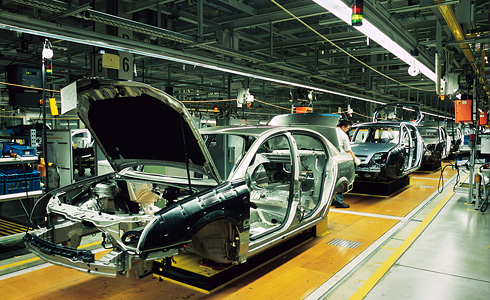Hit by the full force of the economic and financial crisis, the world auto industry saw production fall by 12.5 percent in 2009.
The crisis is durably reshaping the global landscape of the automobile sector
2008-2009: a time of massive destocking
Production down everywhere except China
Behind the total figures, large disparities are disguised: while production fell by 32.3 percent in North America, 31.5 percent in Japan and by 21.9 percent in Europe, Chinese production shot up by 50 percent over the same period. For the first time, in 2009 Chinese output exceed that in North America, where production fell from 12.9 million in 2008 to below 9 million in 2009.
In Europe, despite a strong contraction, Germany retains its number one position, with production twice as great as in France and Spain. Italy, with barely 6 percent of European production, is becoming marginal.
A generalised fall in profitability, except for Korean manufacturers
To cope with the fall in demand, constructors have all carried out massive destocking, radically cutting output to limit their losses and restore liquidity. Despite their energetic responses and despite government support measures and indeed rescues, the major western automakers have all seen their turnover fall and profitability drop into the red.
Karine Berger, Director of Markets and Marketing, and Chief Economic at Euler Hermes, stresses that "The United States have been the most heavily affected, lest we forget the collapse of General Motors and Chrysler. In Europe, two years of strongly diminishing turnover (-17 percent against 2007) saw 2009 post negative operating profits and 2.5 percent fall in turnover."
Largely dependent on exports, Japanese manufacturers were not spared by the trend. Up to that point the champions in terms of growth and profitability, they were caught from the rear by the downturn in their major markets. After rising by 8.5 percent in 2008, their turnover fell by 21.3 percent in 2009 and net profits moved into the red. Karine Berger adds, "Only Korean manufacturers managed to come out of this well, with turnover up by more than 18 percent in 2009 and net result equal to 3.3 percent of turnover."


2010: after two years of turmoil, the world automobile industry has returned to growth
2010: a recovery sustained by new markets
After two years of turmoil, the world automobile industry has returned to growth, but the geography of this recovery confirms the tipping points reached since the end of the 1990s. The clear revival seen
from the start of 2010 is 80 percent due to the strength of demand in the growing economies – China, India and Brazil in the first instance. The migration of demand towards these countries also in fact brings a similar move in production, especially to China and India, where local players are increasing their offensive.
Chinese demand is fuelling the market
With vehicle sales of 13.79 million in 2009, up 48.3 percent on 2008, China has become the world's biggest automobile market, ahead of the United States (8.75 million in 2009). "Everything suggests that China will consolidate its position in years to come: its vehicle ownership rate – at 3 percent in 2008 – is destined to grow, especially because its economic growth is strong, and the government, aiming to increase domestic consumption, is encouraging consumers to buy," says Yann Lacroix, Head of Sectors Studies at Euler Hermes. He adds, "All the western constructors are rushing into this strong growth-potential market, head-to-head with Chinese automakers with their own increasing ambitions."
The Indian market also offers great potential, with the market growing by more than 30 percent a year, an ownership rate in 2008 of just 1.4 percent, and the rise of a large middle class. This market is, however, only a tenth the size of the Chinese market and is developing on the basis of a 'super low cost' model that is a far cry from European vehicle standards.
The United States have not spoken their last word
Since the first quarter of 2010, we have seen a timid recovery in the US market, which should take several years to recover to pre-crisis levels of 16 to 17 million vehicles a year. "The car is still the main means of transport in the US and, with an ownership rate of more than 80 percent, the replacement purchases that the consumers put off during the crisis should gradually resume," Yann Lacroix adds.
2011: what is the outlook for the European automobile sector?
With the end of scrappage incentives in 2010 in France, Germany, the United Kingdom, Spain and Italy, the European market should drop to record lows. Vehicle sales could fall below 13 million units, with a new 8 percent to 10 percent fall in registrations.
Germany: strengths and weaknesses of an export-based model
In the first half of 2010, new registrations fell yr/yr by 30 percent in Germany. While production volumes have not returned to pre-crisis levels, they have been improving since July 2010 and should post an annual increase of 8 percent, rising to 5.2 million units over the course of the year.
Germany exports 75 percent of its vehicle production, and in 2009 its market share fell in the US and in Eastern Europe, although it rose in China (8.8 percent of German imports in 2009, against 5.3 percent in 2008) and in Western Europe (60.9 percent of German exports in 2009, against 58.2 percent in 2008). Thanks to their worldwide sales and positioning at the top end of the market, German car manufacturers' turnover this year has returned to pre-crisis levels, although profitability has not yet done the same, due to wage costs and the current product mix.
France, caught between offshoring and overcapacity
Despite the recovery that began in Q3 2009, production volumes in France remain yr/yr below 2.2 million vehicles a year, well below pre-crisis levels. While in 2005 French automakers carried out 52 percent of their manufacturing in France, offshoring – principally affecting entry-level models – caused the figure to drop to 30 percent by the start of 2010. Subcontractors have felt the backlash of the fall in production within the country, worsened by the world crisis. However, with the increase in production volumes, the number of insolvencies has returned to its pre-crisis average.
Yann Lacroix says, "From a trade surplus of 12 billion euros in 2005, the French auto sector has become largely an importer, and, despite some production line closures, the capacity utilisation rate in France remains low, at around 65 percent". He adds, "Although 2010 turnover should be nearly 15 percent down against the 2007 figure, continued cost cutting efforts and growth in the world market should help French manufacturers to recover profitability this year."
Karine Berger says, in conclusion, "The future of the world automobile industry will bring a mutualisation of certain costs. Mergers and alliances are indispensable in order to redistribute production capacities, to finance a strong presence in the emerging countries, and to create product ranges adapted to these markets. It is equally necessary to accelerate research into both electric and hydrogen hybrid technologies, and to adapt factories. The crisis has profoundly altered the world landscape of the auto sector, and redrawing the map of the players has only just begun."
As with all content published on this site, these statements are subject to our Forward Looking Statement disclaimer.
Link to the disclaimer